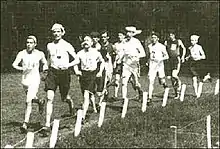Athletics at the 1900 Summer Olympics – Men's marathon
The men's marathon was a track & field athletics event at the 1900 Summer Olympics in Paris. It was held on July 19, 1900. 13 athletes from five nations competed in the marathon, which used a distance of 40.26 kilometres. The winner, Michel Théato, was a native of Luxembourg who was living in Paris. At the time, competitors were not selected and entered by National Olympic Committees. Théato was originally recorded as being French; decades later, after his true nationality was determined, the Grand Duchy of Luxembourg lodged an official complaint with the International Olympic Committee and petitioned to change the Olympic record of Théato's nationality; the complaint was officially rejected in 2004.[1] The race remains officially recorded as France's first Olympic marathon victory.[2] Ernst Fast's bronze was Sweden's first medal in the event.
| Men's marathon at the Games of the II Olympiad | ||||||||||
|---|---|---|---|---|---|---|---|---|---|---|
 The early stages of the race | ||||||||||
| Venue | Paris | |||||||||
| Date | July 19 | |||||||||
| Competitors | 14 from 5 nations | |||||||||
| Winning time | 2:59:45 | |||||||||
| Medalists | ||||||||||
| ||||||||||
| Athletics at the 1900 Summer Olympics | |
|---|---|
| Track events | |
| 60 m | men |
| 100 m | men |
| 200 m | men |
| 400 m | men |
| 800 m | men |
| 1500 m | men |
| 110 m hurdles | men |
| 200 m hurdles | men |
| 400 m hurdles | men |
| 2500 m steeplechase | men |
| 4000 m steeplechase | men |
| 5000 m team race | men |
| Road events | |
| Marathon | men |
| Field events | |
| Long jump | men |
| Triple jump | men |
| High jump | men |
| Pole vault | men |
| Standing long jump | men |
| Standing triple jump | men |
| Standing high jump | men |
| Shot put | men |
| Discus throw | men |
| Hammer throw | men |
Summary
The marathon race, which began at 2:30 p.m. on a day with temperatures reaching nearly 40 °C (102 °F [3]), wound through the streets of Paris. Thirteen runners started, though only twelve finished the four laps around the track that preceded the road running. Touquet-Daunis led until he withdrew from the competition, at which point Fast took over. Fast had tired himself trying to keep pace with the Frenchman, however, and was passed by Théato and Champion before long. Seven runners finished the race.
Background
This was the second appearance of the event, which is one of 12 athletics events to have been held at every Summer Olympics. None of the runners from 1896 returned. The marathon, invented specifically for the 1896 Olympics, was not quite as much a novelty as four years prior; the Boston Marathon had been run every year starting in 1897 (the 1898 winner, Ronald MacDonald of Canada, was among the runners at the 1900 Olympics).
Canada, Great Britain, and Sweden appeared in the event for the first time. France and the United States were the only nations to have runners in both of the first two Olympic marathons.
Competition format
The marathon was a single-race competition. The distance for the event had not yet been standardized; the 1900 version used a course that was 40.26 kilometres in length (compared to the approximately 40 kilometres of 1896 and the 42.195 kilometres later set as the standard). The course started with four laps of the track in the stadium before running through the streets of Paris.[4]
Records
These were the standing world and Olympic records (in hours) prior to the 1900 Summer Olympics. Marathon distances were not standardized and world records or bests were not officially recognized.
| World record | n/a | n/a | n/a | n/a |
| Olympic record | 2'58:50(*) | Athens, Greece | 10 April 1896 (NS) |
(*) Distance was 40 kilometres
Schedule
| Date | Time | Round |
|---|---|---|
| Thursday, 19 July 1900 | 14:30 | Final |
Results
| Rank | Athlete | Nation | Time |
|---|---|---|---|
| Michel Théato | 2:59:45 | ||
| Émile Champion | 3:04:17 | ||
| Ernst Fast | 3:37:14 | ||
| 4 | Eugène Besse | 4:00:43 | |
| 5 | Arthur Newton | 4:04:12 | |
| 6 | Dick Grant | Unknown | |
| 7 | Ronald J. MacDonald | Unknown | |
| — | Auguste Marchais | DNF | |
| Johan Nyström | DNF | ||
| E. Ion Pool | DNF | ||
| Frederick Randall | DNF | ||
| William Saward | DNF | ||
| W. Taylor | DNF[4] | ||
| Georges Touquet-Daunis | DNF | ||
| — | Emilio Banfi | DNS | |
| John Cregan | DNS | ||
| Alexander Grant | DNS | ||
| John Maguire | DNS | ||
| Martens | DNS | ||
| Jakub Wolf | DNS | ||
| Ettore Zilia | DNS |
Sources
- Specific
- "Michel THEATO (1878-1919)". pierrelagrue-jo.com. Retrieved 20 April 2017.
- Olympic.org
- USA Track & Field (2004). "2004 USA Olympic Team Trials: Men's Marathon Media Guide Supplement" (pdf). Santa Barbara, California: USA Track & Field. p. 11. Retrieved 21 February 2011.
- "Marathon, Men". Olympedia. Retrieved 23 August 2020.
- General
- International Olympic Committee results database
- De Wael, Herman. Herman's Full Olympians: "Athletics 1900". Accessed 18 March 2006. Available electronically at .
- Mallon, Bill (1998). The 1900 Olympic Games, Results for All Competitors in All Events, with Commentary. Jefferson, North Carolina: McFarland & Company, Inc., Publishers. ISBN 0-7864-0378-0.